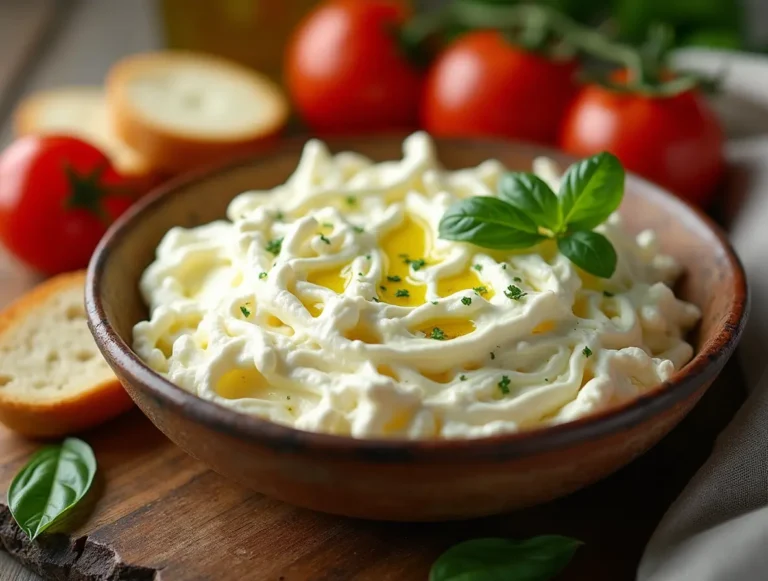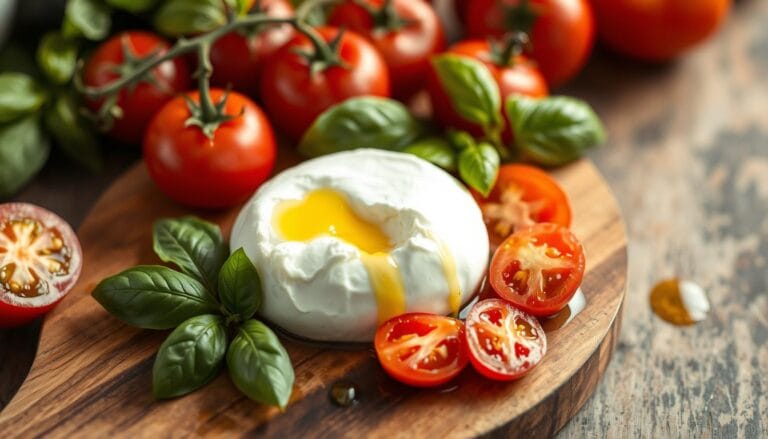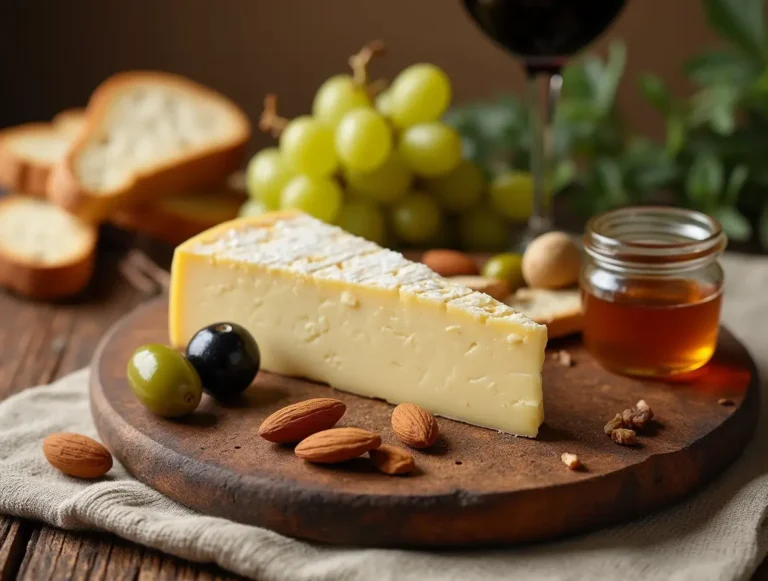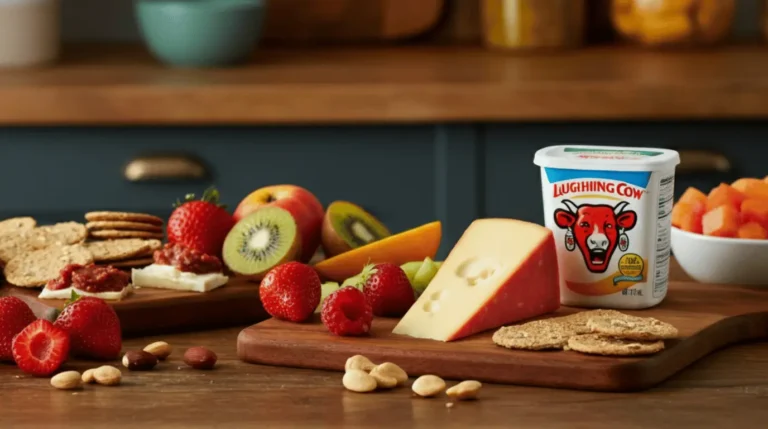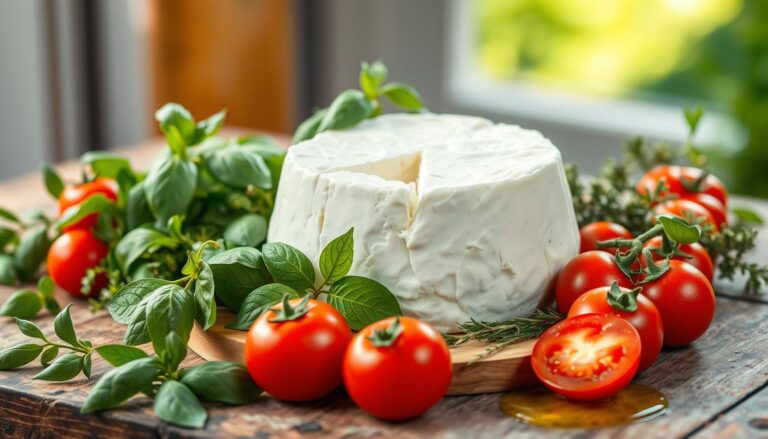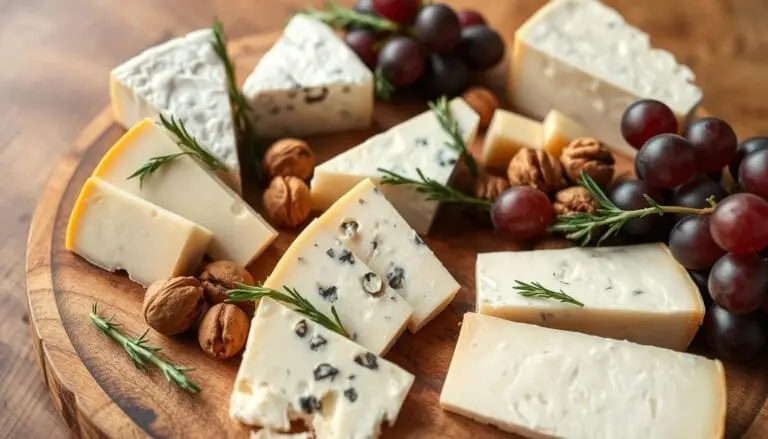Limburger Cheese: Discover the Pungent Delight
I’ve always loved the world of artisanal cheeses. But one cheese really stands out – Limburger cheese. It’s known for its strong smell and creamy texture. This makes Limburger both fascinating and a bit scary for cheese fans.
Limburger comes from Monroe, Wisconsin. It’s a soft cheese made from cow’s milk. As it ages, its smell gets stronger and more complex. But for those brave enough to try it, the taste is amazing.
Table of Contents
What is Limburger Cheese?
Limburger cheese is a soft, pungent cheese with a rich history. It comes from the Limburg region in Belgium, the Netherlands, and Germany. Trappist monks created it in the 19th century. Now, it’s a favorite in German and Alsatian cooking.
Origins and History of Limburger
The story of Limburger cheese starts with Trappist monks in Limburg. They experimented with cheese making. Soon, it became a hit in German and Alsatian cuisine.
German immigrants brought Limburger cheese to the United States. They set up the Limburger industry in Monroe, Wisconsin. Today, Wisconsin is the biggest Limburger cheese maker in the country.
The Distinctive Aroma and Flavor Profile
Limburger cheese is known for its strong smell and taste. It has a grassy, earthy flavor with hints of mushroom. Its soft, creamy texture adds to its appeal.
The smell is intense, but the taste is more subtle. It has a sweet hint that balances out the bold flavors.
| Flavor Notes | Aroma |
|---|---|
| Grassy, earthy, with notes of mushroom | Pungent and distinctive |
| Soft, creamy texture | Balanced by a hint of sweetness |
“Limburger cheese has a flavor profile that is truly unique, with a delicate balance of bold, earthy notes and a touch of sweetness.”
Unveiling the Secrets of Limburger Cheese
Limburger cheese is a favorite among many. It’s made with care, from cow’s milk to aging. Each step shapes its special smell and taste.
The Cheesemaking Process
Limburger cheese starts with traditional methods. First, cow’s milk is mixed with rennet, a natural enzyme. This separates the curds from the whey.
Then, the curds are cut, cooked, and shaped into blocks. These blocks are salted and aged for months.
Bacterial Ripening and Surface Washing
The aging process is key to Limburger’s unique taste. The cheese is washed in brine, which helps Brevibacterium linens bacteria grow. This bacteria gives the cheese its strong smell and complex flavor.
The washing also stops mold from growing. This lets the good bacteria thrive, making Limburger special.
This process makes Limburger stand out. It’s known for its how to make limburger cheese, bacterial ripening, surface washing, brevibacterium linens, and washed-rind cheese qualities.
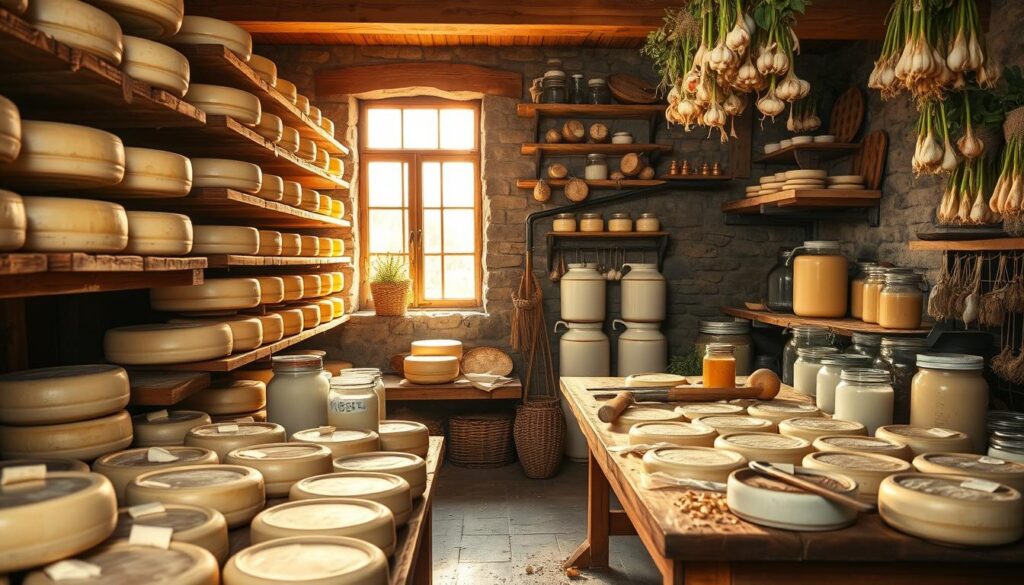
“The surface washing also inhibits the growth of mold, allowing the desired bacteria to thrive and create Limburger’s unique sensory experience.”
Limburger Cheese: A Celebrated Delicacy
Limburger cheese is loved by many. Its strong smell might turn some off, but its soft texture and rich taste make it special. It’s known as one of the world’s top artisanal dairy products.
Limburger’s unique taste sets it apart. It has a big following among those who enjoy bold flavors.
The story of limburger cheese started in the 19th century with German immigrants. Today, it’s a favorite in the Midwest. The Country Castle Limburger by Chalet Cheese Cooperative is the last U.S. maker, keeping the tradition alive.
Despite being known as one of the smelliest cheeses, limburger has many fans. Its special ripening and washing give it a creamy, complex taste. For those who can handle its strong smell, limburger is a unique treat.
| Cheese Variety | Origin | Aging Period | Notable Characteristics |
|---|---|---|---|
| Limburger | Germany | 6-8 weeks | Soft, creamy texture; Strong, pungent aroma |
| Swiss Cheese | Switzerland | 1-3 months | Firm, slightly grainy texture; Mild, nutty flavor |
| Baby Swiss | United States | 1 month | Smaller holes than traditional Swiss; Milder flavor |
| Gouda | Netherlands | 4-10 months | Smooth, creamy texture; Subtle, sweet flavor |
| Parmesan | Italy | 12-36 months | Hard, granular texture; Intense, nutty flavor |
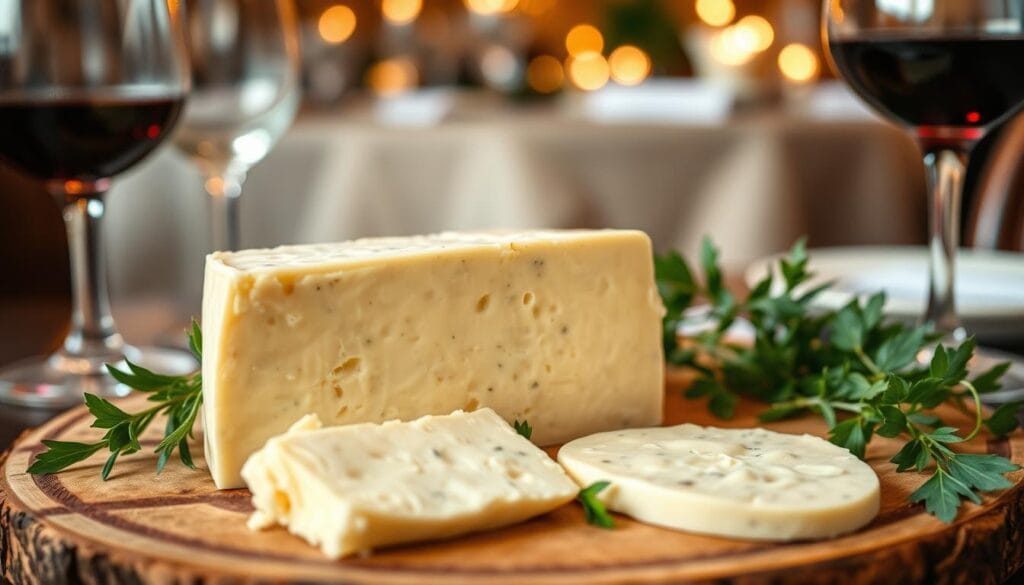
Limburger cheese is a celebrated delicacy loved by many. Its bold taste and history make it a favorite. It’s a choice for those who love to try new and exciting flavors.
Pairing and Serving Limburger Cheese
Complementary Flavors and Beverages
Limburger cheese is known for its strong smell and creamy feel. It goes well with many flavors and drinks. A classic way to enjoy it is on rye bread with onions. The cheese’s sharp taste is balanced by the bread’s earthy sweetness and the onions’ pungency.
For a better experience, pair Limburger with a lager beer or a strong coffee. The beer’s bitterness and the coffee’s roasted flavors complement the cheese. Trying different complementary flavors and beverages can reveal new tastes of Limburger.
The cheese’s creamy texture also matches well with fresh fruit or crackers. This lets the cheese’s special taste stand out. Whether you stick to classic pairings or try new ones, Limburger cheese is exciting to explore.
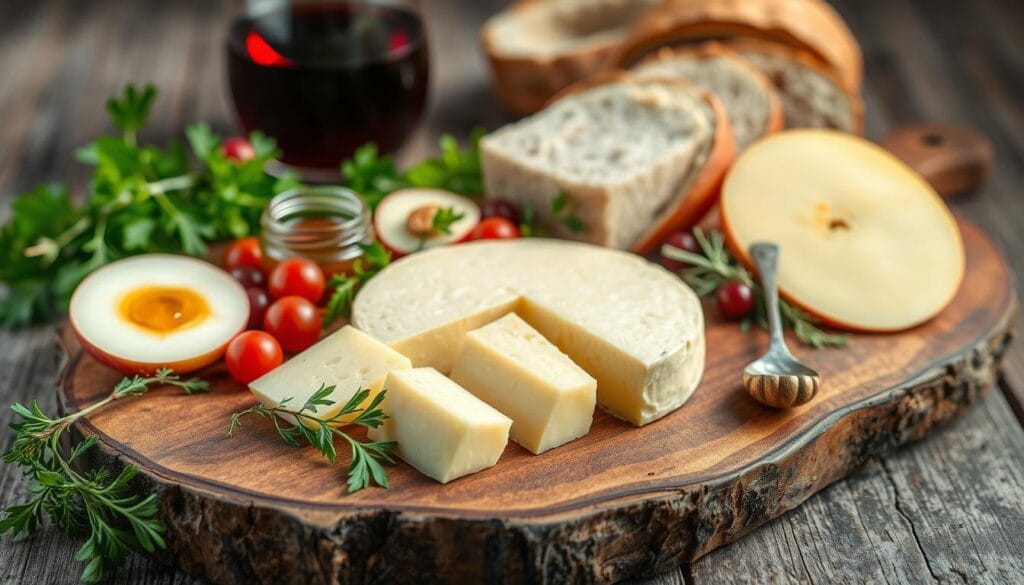
“The perfect pairing for Limburger cheese is a thick slice of rye bread, a few sliced onions, and a cold lager beer or a robust cup of coffee. This classic combination allows the cheese’s unique flavors to truly shine.”
Regional Significance and Cultural Legacy
Limburger cheese is deeply rooted in Wisconsin and the Midwest’s culture. Monroe, Wisconsin, has been making Limburger since the late 1800s. Swiss immigrant Rudolph Benkert started it all.
The Chalet Cheese Co-op in Monroe is the biggest Limburger maker in the U.S. The town’s Cheese Days festival, started in 1914, honors the cheese-making tradition. It celebrates Limburger in a big way.
Limburger in Wisconsin and the Midwest
Wisconsin is famous for its cheese, with 58 Master Cheesemakers leading the way. It’s the only place in the U.S. where you can find Limburger cheese. This shows the region’s skill in making food.
Wisconsin is also known for Colby cheese, made in 1885. It’s the top producer and consumer of bratwurst. Madison’s Brat Fest is a big celebration of this tasty sausage.
The Midwest is more than just cheese. It’s also famous for its brewing and desserts. Wisconsin’s alcohol scene is booming, with many microbreweries.
Frozen custard stands around Milwaukee and Lake Michigan are a big part of Wisconsin’s desserts. They show the region’s love for unique sweets.
Health Benefits of Limburger Cheese
Limburger cheese is known for its strong smell and taste. But it also has health benefits. It has probiotics that help with digestion and supports a healthy gut. It’s also packed with protein, calcium, and other nutrients.
The cheese’s probiotics come from its fermentation process. This process creates beneficial bacteria like Brevibacterium linens. These bacteria help with digestion and boost the immune system.
Limburger cheese is a good source of protein, with about 7 grams per ounce. Protein is key for muscle health and repair. It also has calcium, which is important for strong bones.
But, Limburger cheese should be eaten in small amounts. It’s high in fat and calories. Enjoy it as an occasional treat, not a regular part of your diet.
| Nutrient | Amount per 1-ounce serving of Limburger cheese |
|---|---|
| Calories | 100 |
| Protein | 7 grams |
| Calcium | 200 milligrams |
| Probiotics | Brevibacterium linens |
Limburger cheese may not appeal to everyone because of its strong smell and taste. But, its health benefits make it worth trying in small amounts. It can add flavor to your meals while providing nutritional value.
Limburger Cheese Trivia and Fun Facts
Controversies and the Great Cheese Duel
Limburger cheese has faced many controversies and funny moments. In 1935, a big argument started between the postmasters of Monroe, Wisconsin and Independence, Iowa. They disagreed on whether Limburger could be mailed because of its strong smell. This led to a “great cheese duel” at the Hotel Julien in Dubuque, Iowa.
During this duel, the two postmasters tried to see who could handle the smell better. Limburger’s smell has also caused it to be banned from public transport in France. It has even been featured in the Wallace & Gromit film “The Curse of the Were-Rabbit.”
- Primitive forms of cheese have been made since the domestication of animals.
- Varieties of cheese developed accidentally due to specific conditions like air temperature, humidity, mold, and milk source.
- Cheese making transitioned from art to science with advances in microbiology and chemistry knowledge.
- Cheese making involves removing water from milk while retaining solids for food preservation.
- Essential steps in the fermentation of milk into cheese include inoculating with bacteria, curdling, cutting curd, draining whey, salting, pressing, and ripening.
Milk quality is key for cheese making. It needs good farm sanitation and pasteurization to remove bad microorganisms. Rennet, which has protein-degrading enzymes, helps curdle the milk. Salt adds flavor and helps remove whey from curds, stopping unwanted microorganisms from growing.
Cutting curds into fine wire knives and heating them causes them to shrink. This affects the cheese’s moisture content and final texture. Whey can be used for whey cheeses, drinks, or dried as a food ingredient. Each step in cheese making requires precision and specific conditions to get the right result.
Purchasing and Storing Limburger Cheese
Looking to try Limburger cheese? You can find it at specialty cheese shops, some supermarkets, and online. Look for a firm, creamy texture and an orange-red rind. This shows the cheese is aged right, with a strong aroma and taste.
To keep Limburger fresh at home, wrap it tightly in wax paper or foil and refrigerate. You can also freeze it for longer storage, but it might change texture and taste. Remember, Limburger doesn’t last long, so eat it within a few weeks.
| Cheese Type | Shelf Life |
|---|---|
| Hard Cheeses (Parmigiano-Reggiano, Aged Gouda) | 3-4 weeks |
| Blue Cheeses (Gorgonzola, Roquefort) | 1-2 months |
| Semi-Hard Cheeses (Cheddar, Swiss, Gruyere) | 7-10 days |
| Soft and Semi-Soft Cheeses (Goat Cheese, Camembert, Brie, Limburger) | 1 week |
| Fresh Cheeses (Mozzarella, Feta) | 7-10 days |
Using plastic wrap, wax paper, or cheese paper can keep your Limburger fresh. Always store cheese in the vegetable crisper for the best temperature.
Whether you’re where to buy limburger cheese or how to store limburger cheese, treat it with care. Enjoy its unique flavor.
Conclusion
Limburger cheese shows the amazing variety and depth of the artisanal dairy world. Its strong smell and flavor profile might scare some off. But for those who dare to try it, Limburger offers a deep and satisfying taste experience.
It comes from the Limburg region in Europe and has strong ties to Wisconsin. Limburger cheese is loved by cheese lovers for its bold and unique taste.
Whether you eat it alone or use it in recipes, limburger cheese will excite your taste buds. Its strong aroma and complex flavors make it stand out among artisanal dairy products. Exploring Limburger cheese is a chance to broaden your taste and find new flavors.
From its long history to its current fame, limburger cheese fascinates cheese fans everywhere. Its lasting appeal shows the power of traditional skills and how food connects us to our heritage.
FAQ
Q: What is special about Limburger cheese?
A: Limburger cheese is known for its strong smell and bold taste. It’s soft and creamy, with flavors of grass, earth, and mushrooms.
Q: Is Limburger cheese German?
A: Limburger cheese comes from the Limburg area in Belgium and the Netherlands. German immigrants brought it to the US, starting the Limburger cheese industry in Monroe, Wisconsin.
Q: How do you eat Limburger cheese?
A: You can enjoy Limburger cheese with foods like rye bread and onions. Pair it with a strong lager beer or coffee to balance its intense flavors.
Q: How is Limburger cheese made?
A: Making Limburger cheese involves traditional methods. It starts with cow’s milk, rennet, and curds. The cheese ages for months, gaining its unique taste from bacterial ripening and surface washing.


